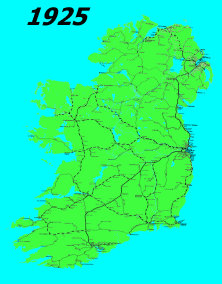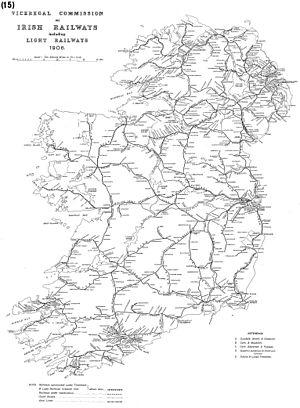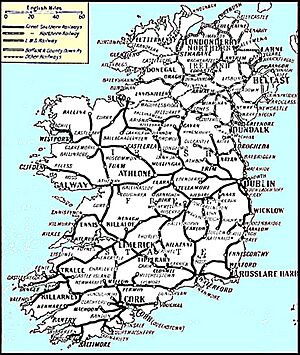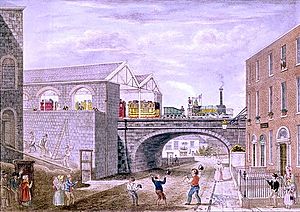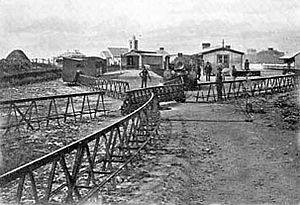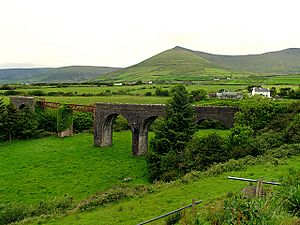History of rail transport in Ireland facts for kids
The history of trains in Ireland started just ten years after trains began running in Great Britain. At its busiest in 1920, Ireland had 5,630 kilometers (3,500 miles) of railway tracks. Today, there's less than half that amount. There are also many areas, especially near the border between Northern Ireland and the Republic of Ireland, that don't have train services anymore.
In the Republic of Ireland, trains are run by Iarnród Éireann (Irish Rail). In Northern Ireland, they are run by NI Railways. These two companies work together to operate the only train service that crosses the border, called the Enterprise, which travels between Dublin and Belfast.
Groups like the Railway Preservation Society of Ireland keep old steam trains running on the main lines. The Irish Traction Group saves old diesel locomotives and also runs them. The Downpatrick and County Down Railway is a special heritage railway where old trains are preserved and run on their own tracks.
Contents
Travel Before Trains
Before trains, people and goods moved around Ireland in different ways. In 1710, the General Post Office started using mail coaches to carry letters between towns. Private companies soon added their own routes. A system of "turnpike" roads, where you paid a fee to use them, began in the 1730s.
Waterways also became important. The first part of the Grand Canal opened in 1779. Later, the Royal Canal and river routes, especially on the River Shannon, made it easier to transport goods. For passengers, Charles Bianconi started his horse-car services in 1815. Even with these improvements, many parts of Ireland still had very basic roads, and canals could be expensive. This meant there was a big need for a faster and cheaper way to travel.
Ireland's First Train Line
Even though a train line between Limerick and Waterford was approved in 1826, the very first railway in Ireland wasn't built until 1834. This was the Dublin and Kingstown Railway (D&KR). It connected Westland Row in Dublin to Kingstown (now Dún Laoghaire), a distance of about 10 kilometers (6 miles).
The person who built this railway, and many other main lines in Ireland, was William Dargan. He is often called "the founder of railways in Ireland." The D&KR was special because it was one of the world's first railways built specifically for people traveling to and from work every day.
On October 9, 1834, the train called Hibernia made the first full trip from Westland Row (now Dublin Pearse) to Kingstown. This railway was built using a standard track width of 1,435 millimeters (4 feet 8.5 inches). Today, this entire route is part of Dublin's electric commuter train system, the Dublin Area Rapid Transit.
Train Track Sizes
Most main train lines in Ireland use a special track width of 1,600 millimeters (5 feet 3 inches). This unusual size is also found in some parts of Australia and Brazil.
When railways first started in Ireland, they had different track sizes. The Dublin and Kingstown Railway used 1,435 mm. The Ulster Railway used 1,880 mm (6 feet 2 inches). And the Dublin and Drogheda Railway used 1,575 mm (5 feet 2 inches). This caused problems because trains couldn't easily move from one line to another.
In 1843, officials decided that all main lines should use the 1,600 mm (5 feet 3 inches) size. The Ulster Railway was paid money to change its tracks to this new standard.
Other Early Railways
Besides the main lines, many smaller, independent railways were built across Ireland. These often used narrower tracks, like 914 mm (3 feet) or 1,067 mm (3 feet 6 inches). Some examples include:
- The Ballycastle Railway (914 mm gauge), which opened in 1880.
- The Cavan and Leitrim Light Railway (914 mm gauge), which opened in 1888.
- The Cork, Blackrock and Passage Railway, which started with a wider gauge but changed to 914 mm in 1900.
- The Giant's Causeway, Portrush and Bush Valley Railway & Tramway (914 mm gauge), an early electric tramway.
Monorail System
Ireland even had the world's first commercial monorail! This was the Listowel and Ballybunion Railway, which opened in 1888. It used a unique system called the Lartigue system, where the train rode on a single rail. It ran between Listowel and Ballybunion in County Kerry until 1924. Today, you can see a modern version of this monorail in Listowel.
Irish Railways in the 20th Century
The train system in Ireland survived the country gaining independence. However, the Irish Civil War (1922-1923) caused a lot of damage to the railways in the new Irish Free State. Groups fighting against the government often attacked the train lines. The government had to build special protected buildings to keep the railways safe. One major attack was the bombing of the viaduct (a bridge-like structure) at Mallow.
In 1925, many railway companies in the Irish Free State joined together to form the Great Southern Railways. Later, in 1945, this company merged with the Dublin United Transport Company to create Córas Iompair Éireann (CIÉ), which became the main transport company in the Republic of Ireland.
The division of Ireland into the Republic and Northern Ireland also affected the railways. Many train lines that crossed the new border eventually closed.
World War II (1939-1945) was also tough on the railways in the Republic. Because Ireland was neutral, Britain couldn't send coal for the trains. Irish steam engines often had to run on poor quality Irish coal, wood, or sometimes not at all. This made train travel less reliable, and fewer people used them.
Switch to Diesel Trains
After the war, Ireland quickly switched from steam trains to diesel locomotives. Many old steam engines were worn out, and there wasn't enough coal. In 1951, CIÉ got its first diesel trains, and in 1953, they ordered 100 more. This helped modernize the railway system.
Closing Lines and Modernization
In the 1950s and 1960s, many train lines in the Republic of Ireland were closed. While this reduced the total length of tracks, most of the main routes connecting Dublin to major cities like Belfast, Sligo, Galway, Limerick, Cork, Waterford, and Wexford remained open.
One important line that closed was the Dublin and South Eastern Railway's Harcourt Street railway line in Dublin. However, much of this route reopened in 2004 as part of the new Luas tram system.
In Northern Ireland, the Ulster Transport Authority also closed many lines, leaving only routes from Belfast to Derry, Dublin, Larne, and Bangor. This created a large gap in the island's train network, with no train service to big towns like Letterkenny and Monaghan.
1970s and 1980s: Challenges and Improvements
For a long time in the 1970s and 1980s, there wasn't much money invested in the train system. The main exception was the Dublin Area Rapid Transit (DART). This project electrified the North-South commuter line in Dublin, and new, frequent DART services started in 1984.
In 1976, CIÉ bought 18 new, fast diesel-electric locomotives from General Motors. These powerful trains could go up to 145 km/h (90 mph) and were used for express services, like the Cork-Dublin line.
Sadly, August 1, 1980, saw a terrible train accident in Buttevant. A train derailed, killing 18 people and injuring many more. The coaches with wooden frames were not safe in a high-speed crash. This accident led to a big review of train safety, and all wooden-bodied coaches were quickly removed from service.
After this, new, safer train carriages were bought. These were based on a proven design from Britain and were built in England and at CIÉ's workshops in Dublin.
1990s: A New Start for Railways
In the 1990s, the Republic of Ireland experienced a strong economy, often called the Celtic Tiger. This allowed for a lot of money to be invested in the railways.
- 34 new powerful locomotives were bought from General Motors.
- New, modern carriages were purchased for the cross-border 'Enterprise' service.
- Old tracks were replaced with modern, continuous welded rail (CWR).
- Old mechanical signaling systems were replaced with electronic ones.
As Dublin's population grew, more people needed to commute. New diesel railcars were ordered for suburban routes. Tracks were doubled in some areas, and new stations like Drumcondra reopened. The DART system also received new carriages.
2000s: More Upgrades
The DART line was extended and electrified further south to Greystones in 2000 and north to Malahide. DART and commuter stations were improved to make them accessible for people with disabilities, with new lifts and longer platforms.
Dublin's main train stations, Dublin Connolly and Dublin Heuston, were upgraded. A new train servicing depot was built in Drogheda.
Iarnród Éireann ordered many new InterCity carriages and "regional railcars" (diesel multiple units) to meet the growing demand. By 2009, all older carriages were retired. Today, most services use modern railcars, except for the Dublin-Cork line and the Enterprise service, which still use locomotive-hauled carriages.
Northern Ireland also saw railway investment. Belfast's Central Station was redesigned, and a more direct line to Derry was reopened. New railcars were introduced.
In March 2007, Docklands railway station opened in Dublin, the first new city center station since 1891. In July 2009, commuter trains started running from Mallow to Cork, and on parts of the reopened Cork to Youghal line to Midleton and Cobh.
2010s: Continued Development
In September 2010, train services began from Dunboyne to Dublin Docklands. This involved reopening a section of an old line that had been closed since 1963. There are plans to extend this line further to Navan in the future.
More modern "22000 Class" railcars were delivered until 2012. The route west to Kildare was expanded to four tracks between 2007 and 2010, allowing more trains to run.
NI Railways also invested heavily, upgrading tracks and introducing 20 new trains, the "Class 4000" units, which started service in 2011 and 2012.
Until 2013, Ireland was the only country in the European Union that hadn't separated its train operations from its railway infrastructure management. This changed in March 2013, when Iarnród Éireann was divided into two parts: one for running trains and one for managing the tracks and stations.
Future Plans for Irish Railways
While plans for new DART trains were put on hold, there are calls to expand the rail network in the Republic of Ireland. The line from Limerick to Waterford is expected to have better services soon.
There's also a railway path that runs from Limerick up through the west of Ireland to Sligo, known as the Western Railway Corridor (WRC). Some people believe this project could help balance railway investment, which has mostly focused on Dublin. The first part of this project, from Ennis to Athenry, opened in March 2010. Future plans would see the line extended to Sligo, connecting to Ireland West Airport Knock.
Images for kids


